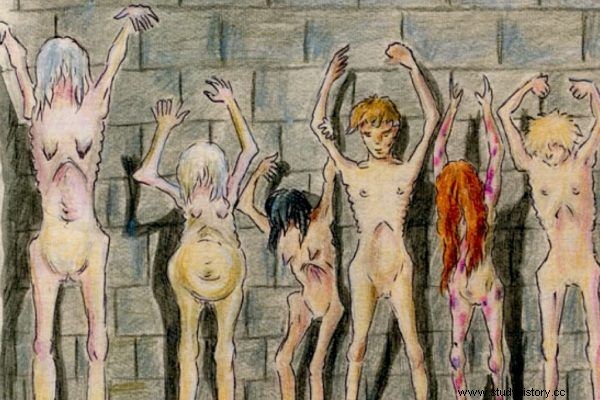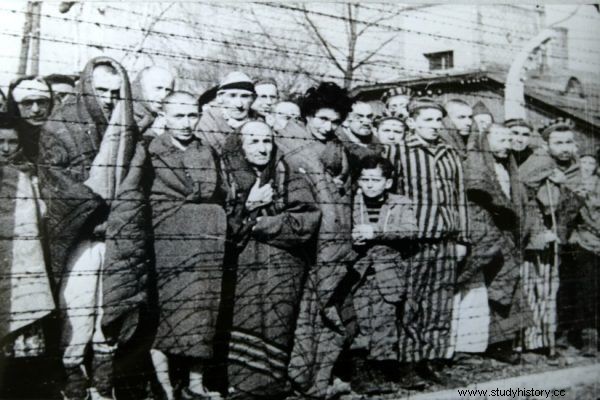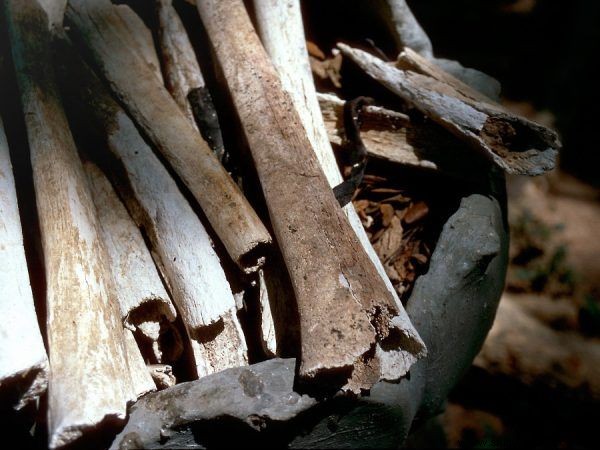Before he killed, he subjected his victims to unimaginable torture. He devastated them slowly and relentlessly. He blinded and sealed his mouth. It brought bloody diarrhea and terrifying diseases. He knew what to do to make the body just ... burst. And he stripped his dignity, ruthlessly suppressing all human impulses.
As always, all TOP10 items are based on the articles we publish. This time we decided to show how a brutal killer hunger, which has killed millions of people over the centuries, can be. I still haven't managed to beat him…
It was hunger that led people to:
10. They had huge scabs instead of their mouths
Terrible hunger was the everyday life of Poles deported to Siberia during World War II. Before dying of malnutrition, people were saved by looking for carcasses on the steppe. In the labor camp in Vorkuta, for breakfast there was soup cooked in weeds for cattle and a thimble of oil, resembling machine grease. The bread looked and tasted like a piece of clay. After work, you could refresh yourself with a spoonful of porridge with a little oil. There was smelly salty fish from Christmas.

This is what the victims of the Siberian starvation looked like ... (fragment of an illustration from the book by Eufroszyn Antonovna Kersnowska, who spent 12 years in the Gulag, and wrote down and illustrated her memories).
In the tannery, they ate greasy scrapings from tanned hides with a piece of stale bread. They were so disgusting that despite the excruciating hunger, it was difficult to take it in your mouth. The gurts were easier to swallow made of rock-hard salty cheese. You had to keep them in your mouth for an hour to make them hard to chew.
One girl from such a diet had a swollen belly so much that she could not see her feet. She was constantly ill:typhus, dysentery and bloody diarrhea. She was suffering from blind bowel attacks and suffered from night blindness. Eventually she developed scurvy that almost killed her. The disease took a monstrous form: her mouth was overgrown, forming one huge scab. The poor man was unable to eat and only drank through a straw (read more on this topic).
9. They were weak and flaccid as she came back
In the nineteenth century, famine attacked the Galicians so often that the whole land was called "Golitsia and Hunger". Its inhabitants were so weakened that they worked “for half a man”. It is not surprising - they ate for a quarter… Malnutrition caused as many as 50,000 deaths annually. The average life expectancy in this area was under 30 years.

In the second half of the 19th century, famine in Galicia killed up to 50,000 people a year! In the illustration, the painting by Aleksander Kotsis entitled "Matula are asleep" (public domain).
Even in good years, the peasants ate the same thing every day:groats, bran, broad beans and cabbage. Bread was rarely served on the tables, because wheat and rye were sold - all valuable food was exchanged for clothes or shoes. Milk was only in the summer, meat - when the cow died. Typical meals were boiled water with flour, porridge boiled with turnips or carrots, or potatoes with linseed oil.
The situation was worst after the summer of 1889. There was a shortage of oats, beets and potatoes. In winter, horses were killed en masse. However, their meat was not eaten because… the Church categorically opposed it. The children were pale and silent as fish, and the peasants exhausted by hunger fever circled around like ghosts (read more about this).
8. They walked hungry as dogs ... and the dogs ate
Fighting hunger during the Warsaw Uprising was as difficult as fighting the occupiers. For the first few weeks, in the kitchens for the insurgents, you could get a hearty soup with mashed potatoes, beans and sliced horse meat. Horses not only carried supplies, but also served after death. However, they soon began to be missing. Other ingredients were slowly being depleted. In the end, the cooks only have groats left.

Working in the insurgent kitchen was not easy. Especially in such a field facility. At least it was good to put everything in the pot ... (public domain).
The insurgents ate from case to case. Sometimes they found supplies in the apartments they occupied. Usually it was half and half porridge with worms, sometimes biscuits, in exceptional cases canned food. Anyone who found a bottle of melted butter might be lucky. The lack of food was so acute that dog owners had to guard their pets with redoubled vigilance. For hungry neighbors they were just a walking chop.
It got worse with each passing day. They managed to get a certain supply of food when the insurgents seized the grain warehouses in Powiśle. They used the unclean grain found in them to make soup-spit. The name was not due to the foul taste, but the fact that the chaff had to be spit out all the time. A portion of bread was rarely found in the thin soup ... And this reserve eventually ran out. The insurgents stopped getting any food and went hungry like dogs. Hunger was slowly quenching their hope (read more on this).
7. They stuffed the stomach with wood
When German troops tightly surrounded Leningrad in September 1941, three million civilians were confined to the city, which was not prepared for supplies. Already in November, besides flour, cotton pomace and treated pine shavings cellulose were added to the baking process. The loafs baked in such a way resembled grass, but they were a real rarity compared to other food inventions ...

There were acts of cannibalism during the blockade of Leningrad. Therefore, the corpse had to be buried as soon as possible ... In the photo, men burying corpses in the Wołkowski Cemetery (photo:RIA Novosti archive, author:Boris Kudoyaro, license CC-BY-SA 3.0).
The biggest mess was the so-called "yeast extract", made from fermented birch sawdust. After dissolving in hot water it was served as "yeast soup". The disgusting slush extended life for more hours. The "wooden food" provided the residents with only about 300 calories a day. Deprived of their strength and dignity, the people wandered like shadows and finally began to look for food on their own.
For many of them, the sources of protein were the dead bodies lying on the streets. Throughout the city, corpses were found without calves or buttocks. One mother strangled an eighteen-month-old daughter to feed her and three older children. The student murdered and ate his roommate. An unemployed boy murdered his grandmother with an ax, then cooked and ate her liver and lungs ... (read more about this).
6. They dreamed of food
Hunger was also the daily life of KL Auschwitz. The combination of a camp diet with exhausting work was calculated to destroy the prisoners. The camp soup for dinner consisted of watered-down swede and potatoes, sometimes with a bit of groats. Only those who had already seen their hunger in the eye ate it without disgust. The camp bread that came out for dinner was usually moldy and had sawdust in it.

This is what the hungry prisoners looked like next to the barbed wire during the liberation of Auschwitz (public domain).
Coffee in the morning, coffee in the evening, and a little Ava for dinner - the prisoners rhymed, referring to the name of the Avo food extract, added to the soup. Besides, coffee, grain coffee, was a monstrous lure. There was no protein, no fat or no vitamins in the camp diet. It is not surprising then that the malnourished prisoners suffered from constant diarrhea.
To survive, one had to "organize" food. On the Lager black market, an onion or garlic was worth more than a $ 20 coin. No wonder that food and clean water often appeared in prisoners' dreams ... (read more about this).
5. They fought over the leftover cornmeal
In the Chinese re-education labor camps under Mao Tse Tung, breakfast was the most important meal of the day. The prisoners were given boiled cabbage or turnips mixed with corn flour. This dish was called "gu". The forced laborers, divided into teams, took the vats of food and shared it on their own.

Such torture was used on Chinese prisoners half a century earlier ... in Mao's time, they preferred to starve and harass the inmates (photo:Hawley C. White, license CC BY-SA 2.0).
The portions did not satisfy the hunger of exhausted with hard work inmates. In the first days there were often fights over who would be licked off the leftovers . Only later did the prisoners decide to do it one by one. Thanks to this, each of them was reasonably full… at least once in a while.
At breakfast, rations for "dinner" were distributed, usually in the form of a corn roll. This second "meal" was usually eaten right away. When one of the inmates stored an extra ration until noon and only then fed, dozens of pairs of hungry eyes focused on him successfully drove him away from similar experiments ... (read more about this).
4. They were selling their own children
In the streets of London in the 19th century, people sometimes starved to death. London poverty researcher Henry Mayhew recalled a young man who wrote "I'm Starving" in chalk on a footbridge. It was curled up in a pile and looked dead from cold and misery.

Hunger was everyday life in London. A painting by Christian Krohg entitled "Fight for survival" (public domain).
Both children and adults could theoretically seek shelter in shelters called Nursing Homes or Homes for the Poor. These places were to provide them with a dignified stay, shelter and meals. In practice, they turned into small labor camps. And while the upper classes were flooded with wealth and money, millions of people were starving in the neighborhoods of poverty nearby.
Poverty and malnutrition hit hardest for the children who crowded the streets of London. To find anything to eat, they stole, begged and traded whatever they could. Many of the ragged youngsters have been abandoned by their parents or even simply sold. Parents received 20-30 shillings for putting the four-year-old over the deadline (read more about this).
3. They hunted comrades in misery
At the beginning of the fourteenth century, the people of almost all Europe became painfully aware of the ruthless executioner of hunger. In the fall of 1314, heavy rains drowned European crops in the water. After the fateful harvest, the time of severe winters has come. In 1315 he was already forcibly fasting the entire continent.

In the years 1315-1317, the famine resulted in the death of as many as six million Europeans! Illustration from the "Pauperum Bible" depicting hunger (public domain).
The plague subsided after two years, but the scale of the tragedy was beyond imagination. Europe felt its effects for many decades. It is no wonder, because about six million people died in a short time. It was almost ten percent of the continent's inhabitants at that time!
Cannibalism has become commonplace. The cannibals did not always wait for the death of their comrades in misery. You could be "dinner" at any moment for a neighbor lurking in an alley or a relative who is crazed by hunger. Death was literally around every corner (read more on that).
2. They were able to kill the pregnant woman
The seventh commandment of the Khmer Rouge was:"You shall drink no more or eat anything else but what is the product of the revolution." However, the revolution was unable to feed the people, so soon after the introduction of communism in Cambodia there was an overwhelming hunger.

Tal looked like the bones of the victims dug in the Cambodian killing fields (photo:Oliver Spalt, license CC BY-SA 2.5).
Hundreds of thousands of people, mostly well-educated, died as a result of malnutrition combined with murderous forced labor in the fields. Only a few survived the hecatomb in Cambodian death factories. But also beyond them, the situation of the population was tragic. The whole country, ravaged by Pol Pot, turned into hell.
Cannibalism was rampant on a massive scale. People went mad with hunger and ate not only the dead rats, but even their own children and neighbors. Hanig Ngor, who survived this communist hell, recalls that in his camp hungry prisoners tortured a pregnant woman, threw the fetus out and ate her insides (read more about this).
1. They became cannibals, insensitive to someone else's death
The Ukrainian Great Famine, triggered by the ruthless actions of the Soviet authorities in 1932-1933, was a crime on an unprecedented scale. Up to seven million people died. Mandatory food supply quotas imposed on the villages exceeded their production capacity. In order to meet the standards, people's livelihoods were taken away. And they, defending themselves against starvation, went to the extreme.

The corpses of those who died of hunger on a street in Kharkiv in 1932 (photo:Alexander Wienerberger, public domain).
Cannibalism was ubiquitous near Kiev, and in one village the children were so swollen, with wounds and scabs, that their bodies were literally bursting. When they suddenly fell silent one day, the adults were terrified to discover that had just eaten the smallest of themselves.
Meanwhile, in Moscow, only the successes of the five-year plan were written. Stalin was also echoed by Western correspondents who ignored or disregarded mass starvation, because "after all, they are only Russians ...". One of the few who tried to inform honestly about the situation in Ukraine was Gareth Jones. In his reports, he conveyed the words of the starving: We don't have bread! We're dying! The pursuit of the truth, however, resulted in a career collapse and death in "mysterious circumstances" (read more about this).
You can read more about the cruelest killer in history in the book "Hunger" by Caparros Martin.
